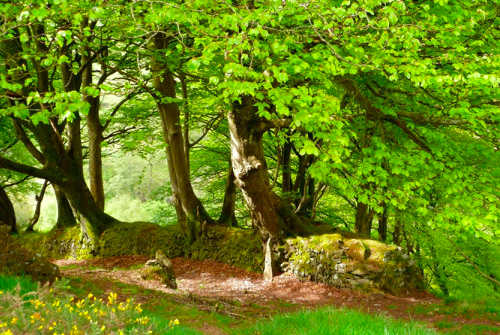
The inherent value and huge potential of trees, woods and forests on Exmoor has been revealed in an authoritative report which has just been released by the Silvanus Trust and Laura Jones Associates.
The study “Unlocking Exmoor’s Woodland Potential” commissioned by a partnership including The Exmoor Society, Exmoor National Park Authority and the Forestry Commission, sets out a new understanding of the ways in which woodland on Exmoor can contribute to ecological, economic and community sustainability and how these might be developed and strengthened in the future.
The comprehensive work is welcomed by the commissioning partnership as an analysis of the many issues relating to Exmoor’s woodlands, recognising their richness and diversity and the many activities being carried out within them. It points the way ahead with eighteen recommendations on further opportunities to develop their full potential. Set within the context of a National Park with Statutory Purposes and special qualities, it shows how these can be used as “anchors through change” and guide future decisions. Although the landscape and ecological significance is widely acknowledged, the National Park’s rich cultural and historical associations with woodlands and the story they tell over the millennia, is largely unrecognised and uninterpreted. Part of the legacy of these associations is the landscape character today and the benefits that visitors and communities draw from them.
Rachel Thomas, Chairman of the Exmoor Society said: “The wider cultural services (including education, recreation and access) found in such an unusual concentration on Exmoor should form the basis of a major theme and a much wider project that could seek special funding. This would be at the heart of developing the woodland culture of Exmoor.”
One of the major challenges the report highlights is that of understanding and adapting to climate change as it is one of the key drivers that will affect Exmoor’s woodlands in the future. Helping woodlands develop resistance to pests and diseases and extreme weather events is particularly important, as is promoting resilience and ability for species and habitats to adapt to these inevitable changes. Indeed the first recommendation of the Report is to apply the principles and priorities of adaptation to Exmoor’s woodlands and this will require considerable attention and resources.
Graeme McVittie, Woodland Officer for the ENPA said: “The Government in their recent Forestry Policy Statement gives a high priority to protect, improve and expand England’s woodland, and this report shows that although a great deal is being delivered already through the National Park Partnership Plan, we believe more can be done by bringing the three themes of woodlands good for people, good for nature, and good for economy together.”
The partners hope that the report highlights that Exmoor’s woodlands deserve to be seen at the same level as the big Exmoor themes, such as its moorlands. Four out of nine Landscape types on Exmoor are characterised by woodland, and the three National Nature Reserves (NNR) are woodland .
Continuing this theme that trees and woodlands on Exmoor are of National significance, the report reminds us that Exmoor contains:
- The highest and longest stretch of uninterrupted coastal woodlands in the country
- The rarest trees in the country, four species of endemic white beam found nowhere else in the world
- The tallest tree in England at Dunster, (a 62 m Douglas fir)
- The highest beech plantation in England at Birch Cleave, Simonsbath
- The oldest – one of the greatest concentrations of veteran trees.
All these provide a firm foundation to develop a woodland culture on Exmoor that recognises woodland as an important land use in its own right with the potential of providing a wide range of services in the 21st Century.


























